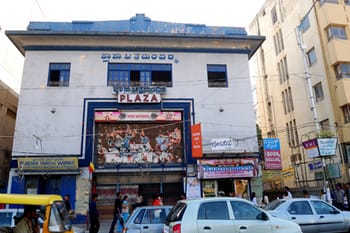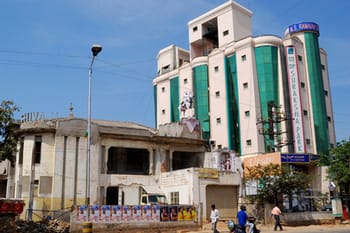If there was one city in the newly independent India that was a real moviegoer’s delight, it had to be Bangalore. In the early ‘50s, cinema theatres in Bangalore used to show films in many languages – Hindi, English, Tamil, Telugu and Kannada. Few years later, Malayalam and Bengali movies could also be seen in morning shows. In that sense Bangalore was probably the most cosmopolitan town in the country. Such a varied taste in films was a reflection of tolerant and eclectic mindset of the natives. May be this was also the way the foundation for a pan-Indian city was being laid!

Plaza Theatre. Pic: Amoghavarsha.
Kempe Gowda Road in the Majestic area had probably the highest number of cinema theatres per square mile in the whole country (the Grant Road area in Bombay would probably come next ). The cinema houses on KG Road included Prabhat (at the beginning of KG Road coming from Mysore Bank Square), States (opposite to Prabhat), Sagar, Kempegowda, Himalaya, Geeta and Majestic. Movieland was also in the same area .
A real modern theatre called Alankar came up on KG Road in the latter half of the ‘50s. Around that time, other theatres like Kalpana, Menaka also came up in the same area. Theatres like Abhinay, Kapali and Tribhuvan were much later additions. In the early ‘70s, the total number of theatres in the Majestic area was about 14! Today KG Road has probably only two of those old theatres left – States and Sagar.
Theatres in the Cantonment area (present day MG Road and Brigade Road) showed mostly English films except for New Opera and Empire. English film theatres included Liberty (Globe in an earlier avatar), Plaza, Rex, BRV and Imperial. Two theatres in the city area used to show older (second run) English films – Vijayalakshmi in Chikpet (which also used to give student discounts – 50 naya paise for a decent seat at the back) and Bharat Talkies on JC Road.
In the early days most of the family members used to go for night shows in the nearby Minerva Theatre where it would be invariably a movie in Telugu, Tamil or Kannada. We would just walk back at one in the morning, after the film ended. Bharat and Shivaji Theatres were also not far from our Basavanagudi home. There was also Paramount in the city market square.
Basavanagudi got its own theatres like Nanda, Shanti, Swagat in the early ‘ 70s; Uma, and Apsara came up nearby around the same time. There were also several theatres in Malleshwaram like Swastik, Sampige etc. which however were outside our beat.
Recounting the names of theatres and the place they adorned is only half of the story. Films were really a very important part of our growing up. It widened our horizons as no other medium did. Books would do it much later but seeing a film at that age was a very rich experience. At first, it gave us familiarity with languages which were not spoken at home. Especially Hindi and English films showed a life which was still outside our social milieu. Further, English films showed a world which we had only heard of. Since it was also the language of our erstwhile masters made us very keen to learn it well, and learn it fast.

Shivaji Theatre. Pic: Amoghavarsha.
The earliest films one saw were all in bits. As children, we used to go along in our car to bring back adults from theatres. Thus, at times, we got to see part of the action at the very end. One of the films I remember seeing that way was Anandamath with its great nationalist song Vande Mataram. I remember going to Prabhat Theatre once when some film was over and my sister and her friends were waiting in the manager’s room to see actor Dev Anand. Incidentally, the theatre owed its name to the great director Shantaram’s movie company.
The first films we were allowed to see by ourselves were invariably in the nearby theatres. This meant a Telugu or Tamil or Kannada movie at the Minerva theatre (near Lalbagh). There were very few films in Kannada in the earlier years. One remembers films like Jatakaphala and Schoolmaster ( the inspiration behind the recent Baagban). However, the kannada filmdom started seeing better days with Raj Kumar’s Bedara Kannappa.
Our next foray as we started growing up was into Hindi films. Since Hindi was being talked about as the national language of the new nation, it was quite natural that we wanted to be proficient in it. And independent India did come up with some great Hindi films in the first two decades. There were idealistic films like Ek hi rasta (widow remarriage), Sadhana (prostitution), Naya Daur ( man vs. machine), Do ankhe barah hath (reformation of prisoners), Sujata (untouchability), Jagte raho (the rural innocence vs. the evil city) etc. The perceived idealism of Nehru and a regular dose of such films helped us in acquiring liberal roots.
There were also films very tastefully produced like Madhumati, Jhanak jhanak payal baje, Chalti ka naam gadi, Kagaz ke phool etc. These films would make us appreciate the classics of western cinema at a much later date. Raj Kapoor, Nargis, Dilip Kumar, Madhubala, Vaijayanti Mala, Nutan etc. were the unforgettable Hindi film stars from those days. Added to it were greats of the Telugu and Tamil films like Nageshwara Rao, Savithri, Bhanumathi, Shivaji Ganeshan, MGR, Padmini etc. One shudders to think, but it is true that all our ideas of love and romance started from seeing these actors in films in the most impressionable times of our lives !

Himalaya Talkies. Pic: Amoghavarsha.
Going to see an English language film was a real event since at first it mostly meant going to Cantonment area which itself was a cause for celebration. Seeing an English language film was not complete without eating popcorn or nut bars. Then there was the mandatory coffee at the India Coffee House or the Parade Café. Talking to waiters in English was also part of the ritual!
One of my first great English movies was A Roman Holiday with Gregory Peck and Audrey Hepburn. Seeing her in greater and greater roles in the coming years was like watching a childhood friend moving on to greater heights. Little later, there were movies like A Bridge on the river Kwai and The Ten Commandments (screen at Plaza). The latter movie had two intervals and I remember people taking food from home so that they could last for three and odd hours. The present day Hollywood has yet to come up with actors to match some of the giants of those years.
These are my memories as a young boy and a teenager. As I left the teens, I also left Bangalore in the early ‘60s. In my occasional returns to the city, I would hear of the demolition of one old theatre or the other. I even remember being in the city when one venerable theatre was demolished in the thick of the night. Thus, our erstwhile classrooms where we had learnt the ways of life were all disappearing !
Today most of the big theatres have disappeared making room, not for new theatres, but for shops and malls. Compared to those giant theatres of the past, the multiplexes amount only to a bigger drawing room. Thus, the great experience of savoring and sharing delectable moments on the screen with hundreds of people in a huge theatre is now a thing of the past. The collective sigh of relief which would reverberate through the auditorium when the hero saves the heroine from the villain is a memory only for the earlier generation .
⊕
Wow! a great article and very well-written. Who could forget those wonderful treats and not to mention, those trailers from the Films Division!
I too miss the single screen theatres of Bangalore like Symphony, Galaxy, Lido, Naga, Lakshmi and Plaza. Even though the movie-going experience may have changed, it hasn’t really changed altogether.
“The collective sigh of relief which would reverberate through the auditorium when the hero saves the heroine from the villain is a memory only for the earlier generation” – this isn’t entirely true. I recently watched a movie in one of our old theatres Rex, where the exact same thing happened. Even though the theatres may have changed, some of the audience are still the same.
Glad you liked the article. Yes, the news reel was the forerunner of the tv news of today. Documentary itself was a great art and some of them were really superb. I still remember a Satyajit RAy docu on Tgore. DD should start the equivalent of a history channel and could use most of that material. Pramod Naik, thanks you mentioned the documentaries. They were added attractions. And the cartoons too !
Thanks for mentioning names of other theatres too. Glad that some of the experiences i recounted have not disappeared. One of the points I wanted to make was that movies to us were like what TV is for now. We learnt a lot from movies – both good and bad. Thanks again, Vaishnavi
Thank you very much for the wonderful article
Really enjoyed your article sir. As a youngster it feels great to hear about the golden days of Bangalore.
It would be wonderful if you all could share more memories like these
My eyes filled with water
Excellent Article, Brings back a lot of nostalgic memories like the spiral staircase, rock garden, hollywood posters and expresso machine at Galaxy… Watching horror movies in the dark balcony at Naga, the huge garden and tree canteen at LIDO…The bugs at imperial, the coffee and snacks at Cholera Hotel Brigade road..